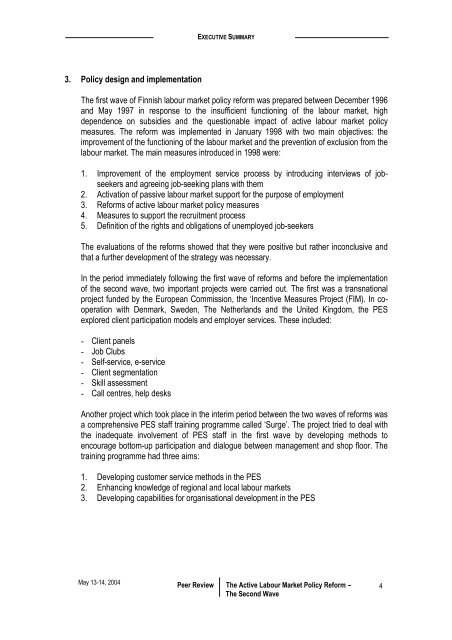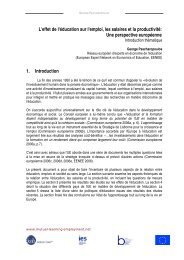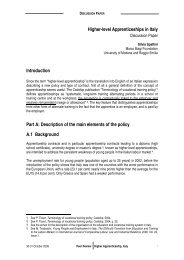The Active Labour Market Policy Reform – The Second Wave
The Active Labour Market Policy Reform – The Second Wave
The Active Labour Market Policy Reform – The Second Wave
Create successful ePaper yourself
Turn your PDF publications into a flip-book with our unique Google optimized e-Paper software.
3. <strong>Policy</strong> design and implementation<br />
May 13-14, 2004<br />
EXECUTIVE SUMMARY<br />
<strong>The</strong> first wave of Finnish labour market policy reform was prepared between December 1996<br />
and May 1997 in response to the insufficient functioning of the labour market, high<br />
dependence on subsidies and the questionable impact of active labour market policy<br />
measures. <strong>The</strong> reform was implemented in January 1998 with two main objectives: the<br />
improvement of the functioning of the labour market and the prevention of exclusion from the<br />
labour market. <strong>The</strong> main measures introduced in 1998 were:<br />
1. Improvement of the employment service process by introducing interviews of jobseekers<br />
and agreeing job-seeking plans with them<br />
2. Activation of passive labour market support for the purpose of employment<br />
3. <strong>Reform</strong>s of active labour market policy measures<br />
4. Measures to support the recruitment process<br />
5. Definition of the rights and obligations of unemployed job-seekers<br />
<strong>The</strong> evaluations of the reforms showed that they were positive but rather inconclusive and<br />
that a further development of the strategy was necessary.<br />
In the period immediately following the first wave of reforms and before the implementation<br />
of the second wave, two important projects were carried out. <strong>The</strong> first was a transnational<br />
project funded by the European Commission, the ‘Incentive Measures Project (FIM). In cooperation<br />
with Denmark, Sweden, <strong>The</strong> Netherlands and the United Kingdom, the PES<br />
explored client participation models and employer services. <strong>The</strong>se included:<br />
- Client panels<br />
- Job Clubs<br />
- Self-service, e-service<br />
- Client segmentation<br />
- Skill assessment<br />
- Call centres, help desks<br />
Another project which took place in the interim period between the two waves of reforms was<br />
a comprehensive PES staff training programme called ‘Surge’. <strong>The</strong> project tried to deal with<br />
the inadequate involvement of PES staff in the first wave by developing methods to<br />
encourage bottom-up participation and dialogue between management and shop floor. <strong>The</strong><br />
training programme had three aims:<br />
1. Developing customer service methods in the PES<br />
2. Enhancing knowledge of regional and local labour markets<br />
3. Developing capabilities for organisational development in the PES<br />
Peer Review <strong>The</strong> <strong>Active</strong> <strong>Labour</strong> <strong>Market</strong> <strong>Policy</strong> <strong>Reform</strong> <strong>–</strong><br />
<strong>The</strong> <strong>Second</strong> <strong>Wave</strong><br />
4





